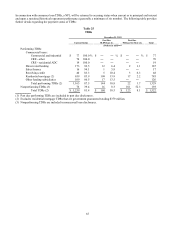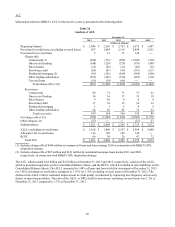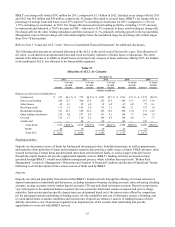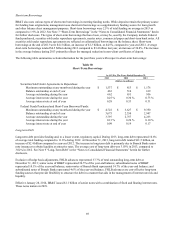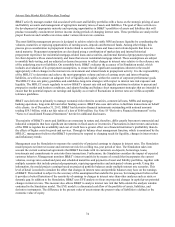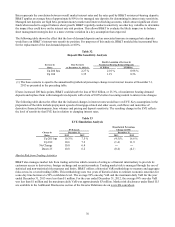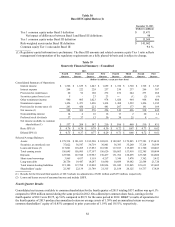BB&T 2013 Annual Report Download - page 73
Download and view the complete annual report
Please find page 73 of the 2013 BB&T annual report below. You can navigate through the pages in the report by either clicking on the pages listed below, or by using the keyword search tool below to find specific information within the annual report.
73
BB&T’s other lending subsidiaries adhere to the same overall underwriting approach as the commercial and consumer
lending portfolio and also utilize automated credit scoring to assist with underwriting credit risk. The majority of these loans
are relatively homogenous and no single loan is individually significant in terms of its size and potential risk of loss. The
majority of the loans are secured by real estate, automobiles, equipment or unearned insurance premiums. As of December
31, 2013, included in the other lending subsidiaries portfolio are loans to nonprime borrowers of approximately $2.8 billion,
or 2.4% of the total BB&T loan and lease portfolio.
Covered Loan Portfolio
BB&T has $2.0 billion of loans covered by loss sharing agreements with the FDIC, which are primarily CRE and residential
mortgage loans. Refer to Note 3 “Loans and ACL” in the “Notes to Consolidated Financial Statements” in this report for
additional disclosures related to BB&T’s covered loans.
Liquidity risk
Liquidity risk is the risk to ongoing operations arising from the inability to accommodate liability maturities or deposit
withdrawals, fund asset growth, or meet contractual obligations when they come due. For additional information concerning
BB&T’s management of liquidity risk, see the “Liquidity” section of “Management’s Discussion and Analysis” herein.
Market risk
Market risk is the risk to earnings or capital arising from changes in the market value of portfolios, securities, or other
financial instruments due to changes in the level, volatility, or correlations among financial market rates or prices, including
interest rates, foreign exchange rates, equity prices, or other relevant rates or prices. For additional information concerning
BB&T’s management of market risk, see the “Market Risk Management” section of “Management’s Discussion and
Analysis” herein.
Operational risk
Operational risk is the risk to earnings or capital arising from inadequate or failed internal processes, people and systems or
from external events. This definition includes legal risk, which is the risk of loss arising from defective transactions, litigation
or claims made, or the failure to adequately protect company-owned assets.
Reputation risk
Reputation risk is the risk to earnings, capital, enterprise value, the BB&T brand, and public confidence arising from negative
publicity or public opinion, whether real or perceived, regarding BB&T’s business practices, products and services,
transactions, or other activities undertaken by BB&T, its representatives, or its partners. Reputation risk may impact BB&T’s
clients, employees, communities or shareholders, and is often a residual risk that arises when other risks are not managed
properly.
Strategic risk
Strategic risk is the risk to earnings, capital, enterprise value, and to the achievement of BB&T’s Vision, Mission, Purpose,
and business objectives that arises from BB&T’s business strategy, adverse business decisions, improper or ineffective
implementation of decisions, or lack of responsiveness to changes in business environment. Strategic risk is a function of the
compatibility of BB&T’s strategic goals, the business strategies developed to achieve those goals, the resources deployed
against these goals, and the quality of implementation.
Market Risk Management
The effective management of market risk is essential to achieving BB&T’s strategic financial objectives. As a financial
institution, BB&T’s most significant market risk exposure is interest rate risk in its balance sheet; however, market risk also
includes product liquidity risk, price risk and volatility risk in BB&T’s LOBs. The primary objectives of market risk
management are to minimize any adverse effect that changes in market risk factors may have on net interest income, net
income and capital and to offset the risk of price changes for certain assets recorded at fair value. At BB&T, market risk
management also includes the enterprise-wide IPV function.




